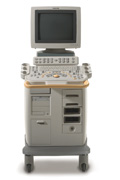Medical Ultrasound Imaging
Thursday, 31 October 2024
'Velocity' p4 Searchterm 'Velocity' found in 49 articles 7 terms [ • ] - 42 definitions [• ] Result Pages : •
Doppler Shift is the change in the perceived frequency relative to the transmitted frequency. The Doppler shift is dependent on the insonating frequency, the velocity of moving blood, and the angle between the sound beam and direction of moving blood. Doppler equation: Doppler shift frequency: fD = fr - f0 = 2f0v/c Where fD is the Doppler shift frequency = the difference between transmitted and received frequencies. Ultrasound system use the following equation: Doppler shift frequency with incident angle: fD = 2f0v/c cosØ Where f is the transmitted frequency, v is the blood velocity, c is the speed of sound in tissue, cosØ is the Cosine of the blood flow to beam angle. The Doppler angle (theta) is the angle of incidence of the beam upon the object. If the beam is parallel to the flowing blood, the angle theta is zero, and the determination of flow is most accurate. If the angle of incidence is greater, the results are less reliable. Doppler shift results with an angle greater than 20° should not be used for the calculation. See also Doppler Interrogation Frequency, Zero Crossing Detector, Doppler Effect, Doppler Ultrasound and Motion Discrimination Detector. •
The Doppler spectrum indicates how the echo power is distributed according to the Doppler shift frequency. The Doppler shift frequency is directly related to the radial velocity of the scatterer.
See also Modal Velocity, Doppler Effect and Doppler Ultrasound. Further Reading: News & More: •
Blood volume per time measured in: cm3/s. The sonographic detection of blood flow in vascular ultrasound is limited by factors such as tissue motion (clutter), attenuation properties of the intervening tissue, and slow or low-volume flow. Different flow types in human body:
•
Behaves like stationary tissue = stagnant flow.
•
Flow with consistent velocities across a vessel = laminar flow.
•
Laminar flow passes through a stricture or stenosis (in the center fast flow, near the walls the flow spirals) = vortex flow.
•
Flow at different velocities that fluctuates = turbulent flow.
See also Antegrade, Bi-directional Flow, Velocity, Poiseulles Law, and Venous Ultrasound. Further Reading: Basics:
News & More:
•  From Philips Medical Systems;
From Philips Medical Systems;'Clinicians are demanding smaller, higher performing systems specifically designed to meet their clinical and operational challenges. The new Philips HD11 system provides an uncompromising platform, plus advanced options in a highly mobile and easy-to-use system.'
Device Information and Specification
APPLICATIONS
Abdominal, cardiac (also for adults with TEE), musculoskeletal (also pediatric), OB/GYN, prostate, smallparts, transcranial, vascular
CONFIGURATION
17' high resolution non-interlaced flat CRT, 4 active probe ports
B-mode, M-mode, coded harmonic imaging, color flow mode (CFM), power Doppler imaging (PDI), color Doppler, pulsed wave Doppler, tissue harmonic imaging
IMAGING OPTIONS
CrossXBeam spatial compounding, coded ultrasound acquisition),speckle reduction imaging (SRI), TruScan technology store raw data, CINE review with 4 speed types
OPTIONAL PACKAGE
Transesophageal scanning, stress echo, tissue velocity imaging (TVI), tissue velocity Doppler (TVD), contrast harmonic imaging
STORAGE, CONNECTIVITY, OS
Patient and image archive, HDD, DICOM 3.0, CD/DVD, MOD, Windows-based
DATA PROCESSING
Digital beamformer with 1024 system processing channel technology
H*W*D m (inch.)
1.62 * 0.61 * 0.99 (64 * 24 * 39)
WEIGHT
246 kg (498 lbs.)
POWER CONSUMPTION
less than 1.5 KVA
•
(J) The SI unit of work or energy. Definition: The work done by a force of 1 Newton acting to move an object through a distance of 1 meter in the direction in which the force is applied. Since kinetic energy is one half the mass times the square of the velocity, 1 joule is the kinetic energy of a mass of two kilograms moving at a velocity of 1 m/sec. The joule is named for the British physicist James P. Joule. Result Pages : |
Medical-Ultrasound-Imaging.com
former US-TIP.com
Member of SoftWays' Medical Imaging Group - MR-TIP • Radiology TIP • Medical-Ultrasound-Imaging
Copyright © 2008 - 2024 SoftWays. All rights reserved.
Terms of Use | Privacy Policy | Advertise With Us
former US-TIP.com
Member of SoftWays' Medical Imaging Group - MR-TIP • Radiology TIP • Medical-Ultrasound-Imaging
Copyright © 2008 - 2024 SoftWays. All rights reserved.
Terms of Use | Privacy Policy | Advertise With Us
[last update: 2023-11-06 01:42:00]




